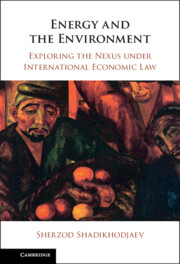Book contents
- Energy and the Environment
- Energy and the Environment
- Copyright page
- Dedication
- Contents
- Figures
- Tables
- Table of Cases
- Table of Treaties
- Table of Other Legal Texts (and Drafts)
- Abbreviations
- Introduction
- 1 Foundations of the Energy–Environment Nexus and International Economic Law
- 2 Energy Trade Control and Environmental Protection
- 3 Energy Subsidies and the Environment
- 4 Pro-environmental Energy Standards and Trade
- 5 Energy Investment Regulation and the Environment
- 6 Energy and Green Technologies
- Conclusion
- Book part
- Bibliography
- Index
2 - Energy Trade Control and Environmental Protection
Published online by Cambridge University Press: 30 April 2024
- Energy and the Environment
- Energy and the Environment
- Copyright page
- Dedication
- Contents
- Figures
- Tables
- Table of Cases
- Table of Treaties
- Table of Other Legal Texts (and Drafts)
- Abbreviations
- Introduction
- 1 Foundations of the Energy–Environment Nexus and International Economic Law
- 2 Energy Trade Control and Environmental Protection
- 3 Energy Subsidies and the Environment
- 4 Pro-environmental Energy Standards and Trade
- 5 Energy Investment Regulation and the Environment
- 6 Energy and Green Technologies
- Conclusion
- Book part
- Bibliography
- Index
Summary
Governments may impose a carbon emission charge to address environmental externalities. If implemented, this will drive up the cost of energy-intensive production. To level the playing field, domestic carbon pricing can be extended to carbon-embedding imports. The recent legislative movements in the EU and elsewhere show that the issue of adjusting carbon prices at the border is entering the mainstream of climate policymaking. At the same time, carbon is not the only target of energy-affecting trade control measures. Other typical examples of such measures include air quality regulations with import-restrictive impacts and the localization of clean energy production, which some States may portray as environmentally necessary. Products with health-threatening content associated with unsafe energy use can face market access barriers as well. When energy production causes ecological or public health problems at home or depletes natural resources, export restrictions are usually among candidate measures that governments consider for mitigating such adverse effects. Therefore, it is imperative to examine trade rules and case law to check the legality of these energy–environment measures.
Keywords
- Type
- Chapter
- Information
- Energy and the EnvironmentExploring the Nexus under International Economic Law, pp. 57 - 98Publisher: Cambridge University PressPrint publication year: 2024

